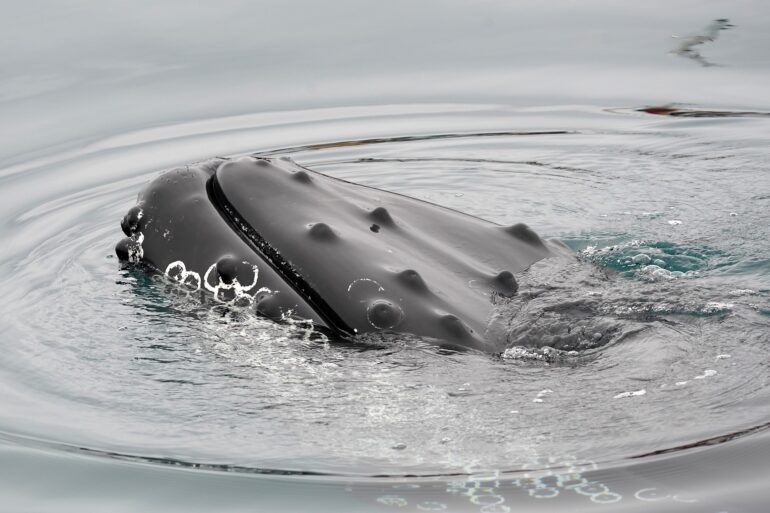- Humpback whale populations are rebounding after decades of whaling.
- Climate change, notably “the blob,” is hindering their recovery, causing a 20% decline in the North Pacific Ocean from 2012 to 2021.
- Ted Cheeseman’s Happy Whale project utilizes AI to identify individual humpback whales through tail markings, aiding in population studies.
- The decline in humpback numbers, particularly in the Alaska-Hawaii migratory group, signifies broader ecological shifts due to climate change.
- Marine heat waves disrupt the food chain, affecting krill populations and consequently humpback whales.
- The decline in humpback whale numbers suggests broader ecological impacts that could affect marine ecosystems and biodiversity.
Main AI News:
In the realm of oceanic conservation, technology emerges as a potent ally, reshaping the dynamics of wildlife monitoring and environmental stewardship. After enduring decades of decimation due to whaling practices, humpback whales are experiencing a remarkable resurgence, reclaiming their presence in the vast expanses of the Pacific Ocean from which they once vanished.
A recent study unveils a concerning trend amid this resurgence, suggesting that climate change might be impeding the humpback whale’s recovery journey. Leveraging the power of artificial intelligence-driven image recognition, researchers have observed a disquieting 20% decline in the humpback population across the North Pacific Ocean between 2012 and 2021.
This decline echoes the repercussions of “the blob,” a formidable marine heat wave that triggered soaring water temperatures spanning from Alaska to California. The ripple effects cascaded through the intricate web of marine life, unsettling fish, avian species, and the majestic whales.
John Calambokidis, a distinguished whale biologist at Cascadia Research and co-author of the study, expresses his apprehension about the rapidity of oceanic transformations. He underscores the heightened vulnerability of long-lived, slow-reproducing species like humpback whales in the face of such accelerated changes.
Innovative Solutions for Conservation
Ted Cheeseman, co-author of the study and a seasoned naturalist with three decades of experience, recalls the stark scarcity of whales during his early expeditions in the 1990s. However, as the years progressed, sightings became more frequent, signaling a tentative rebound in whale populations.
Recognizing the significance of photographic data amassed during his expeditions, Cheeseman embarked on a pioneering venture called Happy Whale. This initiative harnesses the potential of artificial intelligence-powered image recognition to swiftly identify whales based on distinctive markings and patterns, particularly evident in their tails.
Photographs serve as invaluable assets in the endeavor to tally whale populations. As humpbacks gracefully arch their tails above the water’s surface, they unveil a tapestry of unique identifiers crucial for scientific analysis. Through painstaking manual processes, scientists traditionally sift through countless images to catalog and identify individual whales.
Cheeseman’s brainchild, Happy Whale, revolutionizes this tedious endeavor by automating the identification process. Drawing upon a repository of over 200,000 whale images contributed by scientists, whale watching enthusiasts, and citizen scientists, the platform facilitates the seamless sharing of whale identities and sighting locations.
Unveiling Environmental Shifts
The resurgence of humpback whales in the North Pacific Ocean, from a meager count of 1,200 to 1,600 individuals following the era of whaling to an impressive 33,000 by 2012, marked a triumph in conservation efforts. However, recent findings indicate a disconcerting downturn in their numbers, particularly among certain migratory groups.
Of particular concern is the staggering 34% decline observed in a specific cohort of humpback whales migrating between Alaska and Hawaii. These migratory patterns, ingrained over generations, render certain whale populations more vulnerable to environmental perturbations like “the blob.”
The profound ecological shifts induced by marine heat waves pose a formidable challenge to the delicate balance of marine ecosystems. As climate change intensifies, the frequency and severity of such phenomena are poised to escalate, exacerbating existing threats such as ship strikes and entanglements in fishing gear.
Calambokidis emphasizes the critical role of technology, exemplified by initiatives like Happy Whale, in swiftly detecting and responding to these ecological upheavals. While the decline in humpback whale populations serves as a poignant indicator, it also underscores the urgent need for proactive conservation measures and collaborative endeavors to safeguard our oceans’ irreplaceable treasures.
Conclusion:
The decline in humpback whale populations due to climate change underscores the urgent need for environmental action. For businesses operating in marine industries, such as tourism and fishing, this decline signals potential disruptions and underscores the importance of sustainable practices to mitigate further damage to marine ecosystems. Understanding and addressing these ecological shifts will be critical for long-term environmental sustainability and business resilience.

